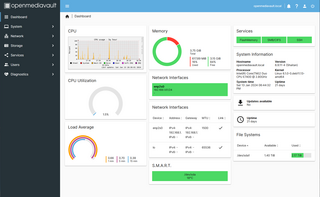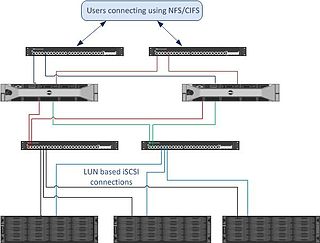In computing, a file server is a computer attached to a network that provides a location for shared disk access, i.e. storage of computer files that can be accessed by workstations within a computer network. The term server highlights the role of the machine in the traditional client–server scheme, where the clients are the workstations using the storage. A file server does not normally perform computational tasks or run programs on behalf of its client workstations.
Network File System (NFS) is a distributed file system protocol originally developed by Sun Microsystems (Sun) in 1984, allowing a user on a client computer to access files over a computer network much like local storage is accessed. NFS, like many other protocols, builds on the Open Network Computing Remote Procedure Call system. NFS is an open IETF standard defined in a Request for Comments (RFC), allowing anyone to implement the protocol.

Server Message Block (SMB) is a communication protocol used to share files, printers, serial ports, and miscellaneous communications between nodes on a network. On Microsoft Windows, the SMB implementation consists of two vaguely named Windows services: "Server" and "Workstation". It uses NTLM or Kerberos protocols for user authentication. It also provides an authenticated inter-process communication (IPC) mechanism.

Network-attached storage (NAS) is a file-level computer data storage server connected to a computer network providing data access to a heterogeneous group of clients. The term "NAS" can refer to both the technology and systems involved, or a specialized device built for such functionality.
Quantum Corporation is a data storage, management, and protection company that provides technology to store, manage, archive, and protect video and unstructured data throughout the data life cycle. Their products are used by enterprises, media and entertainment companies, government agencies, big data companies, and life science organizations. Quantum is headquartered in San Jose, California and has offices around the world, supporting customers globally in addition to working with a network of distributors, VARs, DMRs, OEMs and other suppliers.
GPFS is high-performance clustered file system software developed by IBM. It can be deployed in shared-disk or shared-nothing distributed parallel modes, or a combination of these. It is used by many of the world's largest commercial companies, as well as some of the supercomputers on the Top 500 List. For example, it is the filesystem of the Summit at Oak Ridge National Laboratory which was the #1 fastest supercomputer in the world in the November 2019 Top 500 List. Summit is a 200 Petaflops system composed of more than 9,000 POWER9 processors and 27,000 NVIDIA Volta GPUs. The storage filesystem is called Alpine.
Gluster Inc. was a software company that provided an open source platform for scale-out public and private cloud storage. The company was privately funded and headquartered in Sunnyvale, California, with an engineering center in Bangalore, India. Gluster was funded by Nexus Venture Partners and Index Ventures. Gluster was acquired by Red Hat on October 7, 2011.

Dell EMC Isilon is a scale out network-attached storage platform offered by Dell EMC for high-volume storage, backup and archiving of unstructured data. It provides a cluster-based storage array based on industry standard hardware, and is scalable to 50 petabytes in a single filesystem using its FreeBSD-derived OneFS file system.
A clustered file system (CFS) is a file system which is shared by being simultaneously mounted on multiple servers. There are several approaches to clustering, most of which do not employ a clustered file system. Clustered file systems can provide features like location-independent addressing and redundancy which improve reliability or reduce the complexity of the other parts of the cluster. Parallel file systems are a type of clustered file system that spread data across multiple storage nodes, usually for redundancy or performance.
Grid-oriented Storage (GOS) was a term used for data storage by a university project during the era when the term grid computing was popular.
StorNext File System (SNFS), colloquially referred to as StorNext is a shared disk file system made by Quantum Corporation. StorNext enables multiple Windows, Linux and Apple workstations to access shared block storage over a Fibre Channel network. With the StorNext file system installed, these computers can read and write to the same storage volume at the same time enabling what is known as a "file-locking SAN." StorNext is used in environments where large files must be shared, and accessed simultaneously by users without network delays, or where a file must be available for access by multiple readers starting at different times. Common use cases include multiple video editor environments in feature film, television and general video post production.

The Multi Protocol File System (MPFS) is a multi-path network filesystem technology developed and sold by EMC Corporation. MPFS is intended to allow hundreds to thousands of client computer nodes to access shared computer data with higher performance than conventional NAS file-sharing protocols such as NFS.
The OneFS File System is a parallel distributed networked file system designed by Isilon Systems and is the basis for the Isilon Scale-out Storage Platform. The OneFS file system is controlled and managed by the OneFS Operating System, a FreeBSD variant.
Blue Whale Clustered file system (BWFS) is a shared disk file system made by Tianjin Zhongke Blue Whale Information Technologies Company in China.

OpenMediaVault (OMV) is a free Linux distribution designed for network-attached storage (NAS). The project's lead developer is Volker Theile, who instituted it in 2009. OMV is based on the Debian operating system, and is licensed through the GNU General Public License v3.

Dell Fluid File System, or FluidFS, is a shared-disk filesystem made by Dell that provides distributed file systems to clients. Customers buy an appliance: a combination of purpose-built network-attached storage (NAS) controllers with integrated primary and backup power supplies attached to block level storage via the iSCSI or Fiber Channel protocol. A single Dell FluidFS appliance consists of two controllers operating in concert connecting to the back-end storage area network (SAN). Depending on the storage capacity requirements and user preference, FluidFS version 4 NAS appliances can be used with Compellent or EqualLogic SAN arrays. The EqualLogic FS7600 and FS7610 connect to the client network and to Dell's EqualLogic arrays with either 1 Gbit/s (FS7600) or 10 Gbit/s (FS7610) iSCSI protocol. For Compellent, FluidFS is available with either 1 Gbit/s or 10 Gbit/s iSCSI connectivity to the client network and connection to the backend Compellent SAN can be either 8 Gbit/s Fibre Channel or 10 Gbit/s iSCSI.

Nexenta by DDN, Inc., is a subsidiary of DataDirect Networks that sells computer data storage and backup software. It is headquartered in San Jose, California. Nexenta developed NexentaStor, NexentaCloud, NexentaFusion, and NexentaEdge. It was founded as Nexenta Systems, Inc., in 2005.
ONTAP, Data ONTAP, Clustered Data ONTAP (cDOT), or Data ONTAP 7-Mode is NetApp's proprietary operating system used in storage disk arrays such as NetApp FAS and AFF, ONTAP Select, and Cloud Volumes ONTAP. With the release of version 9.0, NetApp decided to simplify the Data ONTAP name and removed the word "Data" from it, removed the 7-Mode image, therefore, ONTAP 9 is the successor of Clustered Data ONTAP 8.






